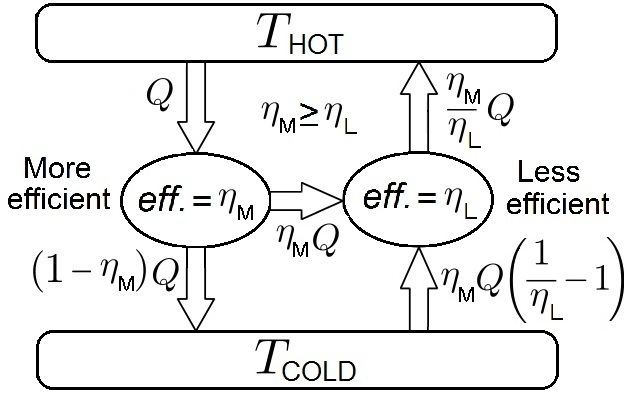 | ||
Carnot's theorem, developed in 1824 by Nicolas Léonard Sadi Carnot, also called Carnot's rule, is a principle that specifies limits on the maximum efficiency any heat engine can obtain. The efficiency of a Carnot engine depends solely on the difference between the hot and cold temperature reservoirs.
Contents
- Proof
- Reversible engines
- Irreversible engines
- Definition of thermodynamic temperature
- Applicability to fuel cells and batteries
- References
Carnot's theorem states:
The formula for this maximum efficiency is
where TC is the absolute temperature of the cold reservoir, TH is the absolute temperature of the hot reservoir, and the efficiency
Based on modern thermodynamics, Carnot's theorem is a result of the second law of thermodynamics. Historically, however, it was based on contemporary caloric theory and preceded the establishment of the second law.
Proof
The proof of the Carnot theorem is a proof by contradiction, or reductio ad absurdum, as illustrated by the figure showing two heat engines operating between two reservoirs of different temperature. The heat engine with more efficiency (
It is generally agreed that this is impossible because it violates the second law of thermodynamics.
We begin by verifying the values of work and heat flow depicted in the figure. First, we must point out an important caveat: the engine with less efficiency (
By restricting our discussion to cases where engine (
The figure is also consistent with the definition of efficiency as
It may seem odd that a hypothetical heat pump with low efficiency is being used to violate the second law of thermodynamics, but the figure of merit for refrigerator units is not efficiency,
Having established that the heat flow values shown in the figure are correct, Carnot's theorem may be proven for irreversible and the reversible heat engines.
Reversible engines
To see that every reversible engine operating between reservoirs
This is an important result because it helps establish the Clausius theorem, which implies that the change in entropy is unique for all reversible processes.,
over all paths (from a to b in V-T space). If this integral were not path independent, then entropy, S, would lose its status as a state variable.
Irreversible engines
If one of the engines is irreversible, it must be the (M) engine, placed so that it reverse drives the less efficient but reversible (L) engine. But if this irreversible engine is more efficient than the reversible engine, (i.e., if
Definition of thermodynamic temperature
The efficiency of the engine is the work divided by the heat introduced to the system or
where wcy is the work done per cycle. Thus, the efficiency depends only on qC/qH.
Because all reversible engines operating between the same heat reservoirs are equally efficient, any reversible heat engine operating between temperatures T1 and T2 must have the same efficiency, meaning, the efficiency is the function of the temperatures only:
In addition, a reversible heat engine operating between temperatures T1 and T3 must have the same efficiency as one consisting of two cycles, one between T1 and another (intermediate) temperature T2, and the second between T2andT3. This can only be the case if
Specializing to the case that
Therefore, if thermodynamic temperature is defined by
then the function f, viewed as a function of thermodynamic temperature, is
and the reference temperature T1 has the value 273.16. (Of course any reference temperature and any positive numerical value could be used—the choice here corresponds to the Kelvin scale.)
It follows immediately that
Substituting Equation 3 back into Equation 1 gives a relationship for the efficiency in terms of temperature:
Applicability to fuel cells and batteries
Since fuel cells and batteries can generate useful power when all components of the system are at the same temperature (
